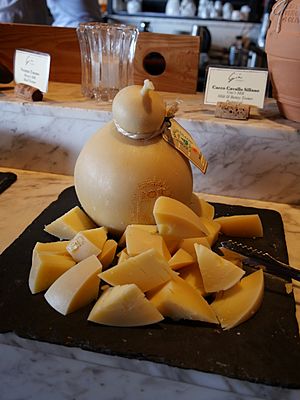Caciocavallo facts for kids
Quick facts for kids Caciocavallo |
|
|---|---|

Whole cheese and cut into pieces
|
|
| Country of origin | Italy |
| Source of milk | Sheep or cow milk |
| Certification | PDO (Caciocavallo Silano) |
| Named after | Lua error in Module:Wikidata at line 70: attempt to index field 'wikibase' (a nil value). |
Caciocavallo is a special kind of cheese from Southern Italy. It's made from the milk of sheep or cows. This cheese is shaped like a teardrop. You can find it especially in the Apennine Mountains and the Gargano area. It tastes a bit like aged Provolone cheese. Caciocavallo has a hard rind that you can eat.
Contents
What Does Caciocavallo Mean?
The name caciocavallo means "horse cheese" in Italian. This name comes from how the cheese is aged. Two cheese forms are often tied together with a rope. Then, they are hung over a horizontal stick or branch. This way of hanging them "straddling" the stick is like riding "a cavallo," or "on horseback."
The Long History of Caciocavallo Cheese
Caciocavallo is one of the oldest known cheeses in the world! It was first mentioned around 500 BC by a famous Greek doctor named Hippocrates. He talked about how clever the Greeks were at making cheese. Later, a Roman writer named Columella described exactly how to make this cheese. He wrote about it in his book on farming around 35–45 AD.
Cheeses with similar names are found in many places. You can find them across the Balkans and in Southern Italy. In Sicily, there was a cheese called "caciocavallo ragusano." But to get a special protected status, it had to change its name to Ragusano DOP.
Different Kinds of Caciocavallo
There are many different types of Caciocavallo in Italy. Several of them are known as traditional regional food products. For example, caciocavallo podolico is made only from the milk of Podolica cows. Another type is caciocavallo di Castelfranco, which comes from the Miscano valley. There is also caciocavallo di Godrano, sometimes called caciocavallo palermitano.
Caciocavallo Silano: A Protected Cheese
Caciocavallo Silano is a special type of Caciocavallo. It is made from cow's milk in certain areas of Southern Italy. These areas include Basilicata, Calabria, Campania, Molise, and Apulia. In 1993, Caciocavallo Silano received a special status called Protected Geographical Status (PDO). This means that only cheese made in these specific regions, following traditional methods, can be called Caciocavallo Silano. It helps protect the quality and tradition of the cheese.
Caciocavallo in Other Languages
Many countries have cheeses with names similar to Caciocavallo. Here are a few examples:
- Albanian: Albanian: kaçkavall
- Bosnian: Bosnian: kačkavalj
- Bulgarian and Macedonian: кашкавал (kashkaval)
- Romanian: Romanian: cașcaval
- Serbian: Serbian: качкаваљ/kačkavalj
- Sicilian: Sicilian: caciucavaddu
- Turkish: Turkish: kaşkaval/kaşar
- Hebrew: Hebrew: קשקבל (kashkaval)
- Greek: Greek: κασκαβάλι (kaskavali), κασέρι (kaseri)
- Arabic: Arabic: قشقوان (kashkawane)
Even though these names sound alike, each of these local cheeses is unique. They are different from Caciocavallo Silano and from each other.
See also
 In Spanish: Caciocavallo para niños
In Spanish: Caciocavallo para niños

